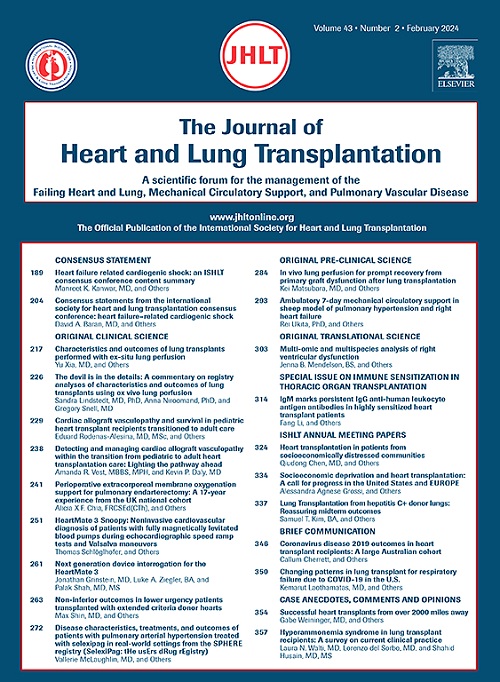肺移植术后长期暴露于空气污染与原发性移植物功能障碍的风险。
IF 6.4
1区 医学
Q1 CARDIAC & CARDIOVASCULAR SYSTEMS
引用次数: 0
摘要
背景:原发性移植物功能障碍(PGD)是肺移植术后短期和长期死亡率的主要原因,但导致原发性移植物功能障碍的机制尚不十分清楚。暴露于环境空气污染物与肺移植等待期间的不良事件和慢性肺异体移植功能障碍有关,但其与 PGD 的关系尚未得到研究。我们假设,肺供体和受体长期暴露于高浓度的环境空气污染物会增加肺移植受体发生 PGD 的风险:利用肺移植结果组(LTOG)观察性队列研究中 1428 名肺移植受者及其供体的数据,我们评估了肺移植受者和肺供体发生 PGD 与基于邮政编码的六种主要空气污染物(臭氧、二氧化氮、二氧化硫、一氧化碳、PM2.5 和 PM10)长期暴露估计值之间的关系。暴露估计值使用了美国环保署的每日空气污染物监测数据,并以每个受试者居住地的邮政编码中心点为基础。在单变量和多变量模型中测试了与已知 PGD 风险因素的相关性:我们没有发现供体或受体暴露于空气污染物与 PGD 之间有很强的关联:本研究中观察到的环境空气污染物暴露水平可能不足以使供体肺部或受体产生 PGD,特别是考虑到与其他已确定的 PGD 危险因素的密切联系。本文章由计算机程序翻译,如有差异,请以英文原文为准。
Long-term air pollution exposure and the risk of primary graft dysfunction after lung transplantation
Background
Primary graft dysfunction (PGD) contributes substantially to both short- and long-term mortality after lung transplantation, but the mechanisms that lead to PGD are not well understood. Exposure to ambient air pollutants is associated with adverse events during waitlisting for lung transplantation and chronic lung allograft dysfunction, but its association with PGD has not been studied. We hypothesized that long-term exposure of the lung donor and recipient to high levels of ambient air pollutants would increase the risk of PGD in lung transplant recipients.
Methods
Using data from 1428 lung transplant recipients and their donors enrolled in the Lung Transplant Outcomes Group observational cohort study, we evaluated the association between the development of PGD and zip-code-based estimates of long-term exposure to 6 major air pollutants (ozone, nitrogen dioxide, sulfur dioxide, carbon monoxide, particulate matter 2.5, and particulate matter 10) in both the lung donor and the lung recipient. Exposure estimates used daily EPA air pollutant monitoring data and were based on the geographic centroid of each subject’s residential zip code. Associations were tested in both univariable and multivariable models controlling for known PGD risk factors.
Results
We did not find strong associations between air pollutant exposures in either the donor or the recipient and PGD.
Conclusions
Exposure to ambient air pollutants, at the levels observed in this study, may not be sufficiently harmful to prime the donor lung or the recipient to develop PGD, particularly when considering the robust associations with other established PGD risk factors.
求助全文
通过发布文献求助,成功后即可免费获取论文全文。
去求助
来源期刊
CiteScore
10.10
自引率
6.70%
发文量
1667
审稿时长
69 days
期刊介绍:
The Journal of Heart and Lung Transplantation, the official publication of the International Society for Heart and Lung Transplantation, brings readers essential scholarly and timely information in the field of cardio-pulmonary transplantation, mechanical and biological support of the failing heart, advanced lung disease (including pulmonary vascular disease) and cell replacement therapy. Importantly, the journal also serves as a medium of communication of pre-clinical sciences in all these rapidly expanding areas.

 求助内容:
求助内容: 应助结果提醒方式:
应助结果提醒方式:


